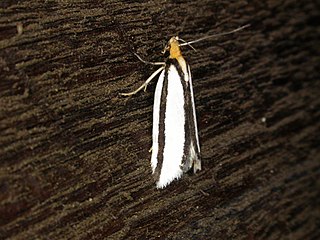
Xylorycta is a genus of moths of the family Xyloryctidae. Xylorycta species are found in Africa and Australia and are strongly associated with the plant family Proteaceae, being found on Hakea, Lambertia, Grevillea, Leptospermum, Macadamia, Oreocallis, Persoonia and Telopea. The larvae of some species bore into stems or branches, or the flower spikes of Banksia, but most live in a silk gallery spun in the foliage.

Xylorycta assimilis is a moth of the family Xyloryctidae. It is found in Australia, where it has been recorded from New South Wales, Queensland and Victoria.
Xylorycta amaloptis is a moth in the family Xyloryctidae. It was described by Oswald Bertram Lower in 1915. It is found in Australia, where it has been recorded from New South Wales.
Xylorycta amphileuca is a moth in the family Xyloryctidae. It was described by Oswald Bertram Lower in 1902. It is found in Australia, where it has been recorded from the Northern Territory and Western Australia.
Xylorycta argyrota is a moth in the family Xyloryctidae. It was described by Oswald Bertram Lower in 1908. It is found in Australia, where it has been recorded from South Australia.
Xylorycta leucophanes is a moth in the family Xyloryctidae. It was described by Oswald Bertram Lower in 1892. It is found in Australia, where it has been recorded from South Australia and Victoria.
Xylorycta parthenistis is a moth in the family Xyloryctidae. It was described by Oswald Bertram Lower in 1902. It is found in Australia, where it has been recorded from the Northern Territory.
Xylorycta sucina is a moth in the family Xyloryctidae. It was described by Turner in 1939. It is found in Australia, where it has been recorded from Tasmania and Victoria.
Xylorycta calligramma is a moth in the family Xyloryctidae. It was described by Edward Meyrick in 1890. It is found in Australia, where it has been recorded from New South Wales.
Xylorycta ophiogramma is a moth in the family Xyloryctidae. It was described by Edward Meyrick in 1890. It is found in Australia, where it has been recorded from Queensland.
Xylorycta cosmopis is a moth in the family Xyloryctidae. It was described by Edward Meyrick in 1890. It is found in Australia, where it has been recorded from Western Australia.
Xylorycta melanula is a moth in the family Xyloryctidae. It was described by Edward Meyrick in 1890. It is found in Australia, where it has been recorded from New South Wales.
Xylorycta maeandria is a moth in the family Xyloryctidae. It was described by Edward Meyrick in 1915. It is found in Australia, where it has been recorded from New South Wales.
Xylorycta perflua is a moth in the family Xyloryctidae. It was described by Edward Meyrick in 1914. It is found in Australia, where it has been recorded from Western Australia.
Xylorycta tignaria is a moth in the family Xyloryctidae. It was described by Edward Meyrick in 1921. It is found in Australia, where it has been recorded from Queensland.
Xylorycta bipunctella is a moth in the family Xyloryctidae. It was described by Francis Walker in 1864. It is found in Australia.
Xylorycta placidella is a moth in the family Xyloryctidae. It was described by Francis Walker in 1864. It is found in Australia, where it has been recorded from New South Wales, Queensland and Victoria.
Xylorycta austera is a moth in the family Xyloryctidae. It was described by Thomas Pennington Lucas in 1898. It is found in Australia, where it has been recorded from New South Wales and Queensland.

Xylorycta strigata, the banksia web-covering borer, is a moth in the family Xyloryctidae. It was described by John Lewin in 1805. It is found in Australia, where it has been recorded from New South Wales, Queensland and South Australia.


